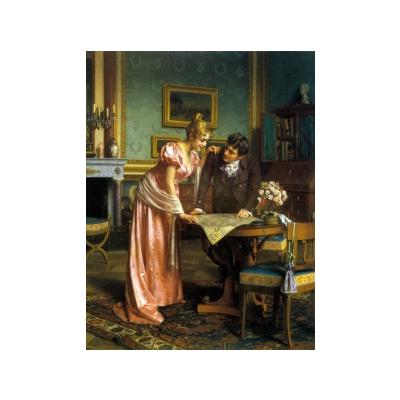
Posted in: Jewelry History
 Emil Brack, Planning the Grand Tour Photo Source: Wikimedia Commons
Emil Brack, Planning the Grand Tour Photo Source: Wikimedia Commons
As mentioned in a previous post, Victorian Jewelry spans three distinctive eras. During the early period (1837-1861), Victorian jewelry reflected the sentimental nature of the times with mementoes, love tokens, and souvenirs from foreign travel. Italian cameos were brought back to Britain from Italy and Greece as souvenirs from the "Grand Tours" of the upper classes. Victoria’s love for all things Scottish popularized many Highlander influences in jewelry and fashion, particularly brooches with a grouse foot set in gold or silver and tartan clothing. These trends lasted well into the 1860s, a time when culture and travel were extremely important to British culture.
In 1861, the death of Prince Albert launched Victoria’s mourning period, and the beginning of mid-Victorian jewelry (1861-1885). From that day until the day of her death, Victoria wore only black clothing and mourning jewelry. The light and airy romantic designs of the early period dramatically transformed into the heavier, bolder, and brighter designs of this later time. Upon the death of the prince, the practice of wearing day jewelry and night jewelry became in vogue.
It was considered improper to wear glittery jewelry during the day, so daytime jewelry became smaller and more subtle, following a classical trend with stones such as agates, shells, amethyst, and jasper. Colorless faceted gems, such as diamonds, were strictly reserved for nighttime wear. As the period progressed, the use of colored stones declined even further, which had a huge impact on the jewelry industry and almost caused the failure of many designers of that time.
Victorian jewelry from the final period of Victoria’s reign, the Aesthetic Period (1885-1901), drew influence from the introduction of Darwin’s theory of evolution. This led to a demand for animal motifs in jewelry. Fashions again changed, becoming a celebration of the greater liberation of women. Softer colors and designs became popular, reflecting the greater emphasis on feminine concerns. Of course, new discoveries and new trade lines opened up during this era, and the jewelry and fashion of the day reflects these discoveries. During this period in particular, silver, diamonds, and sapphires grew in availability and popularity.
11 years ago
3 view(s) 